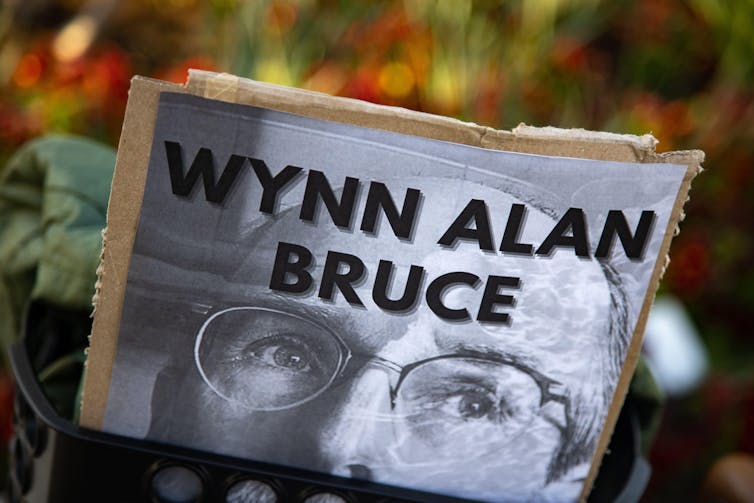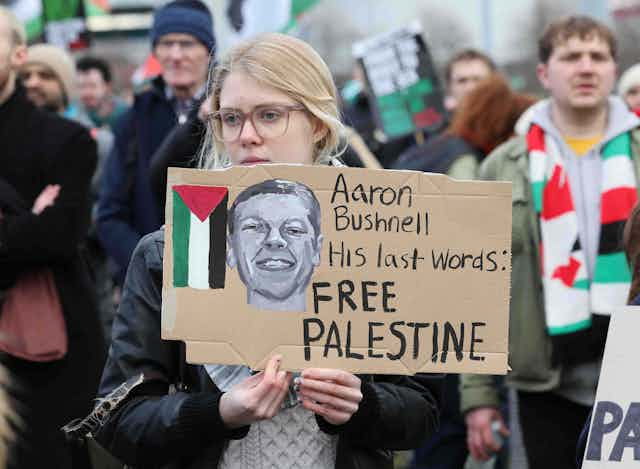Images of Maxwell Azarello, engulfed in flames, spread worldwide recently after he set himself on fire outside the Manhattan court where Donald Trump’s “hush money” trial is being held. It came just months after Aaron Bushnell, a 25-year-old active duty airman, livestreamed his self-immolation at the Israeli embassy in Washington DC, repeatedly yelling “free Palestine”.
Journalists have called these self-immolations “extreme” and “grotesque”, and have obsessed over the “haunting” or “chilling” final messages left by those who died. People have also commented on a decline in the mental health of those involved.
But seeing these protests as fierce demonstrations of self-harm undermines the political claims that motivate them. There is, in fact, a long and often forgotten history of protest self-immolations in the US.
My own research, published in 2018, reveals that hundreds of Americans have demonstrated their political dissent by burning themselves in public. Each had a distinct motive, meaning and critique underpinning their final acts.
Understanding American self-immolations requires a patient and challenging reflection on the role emotions and mental health play in political action.
American self-immolations
Self-immolation became a recognised protest tactic in 1963, after Buddhist monk Thích Quảng Đức burned himself to death in Saigon, South Vietnam. American photojournalist Malcolm Browne captured the spectacle in a widely reproduced photograph.
The protest, which was directed against religious oppression by the South Vietnamese government, also demonstrated Vietnamese opposition to growing US military intervention in the region.

The first American political self-immolation occurred in March 1965. Alice Herz, an 82-year old peace activist and refugee from Nazism, burned herself to death in Detroit to protest the US military’s strategic bombing in Vietnam. A letter sent to her daughter said that she did this “not out of despair, but out of hope for mankind”. Herz wrote: “I have chosen the flaming death of the Buddhists.”
Herz’s life and death quickly faded from the headlines as public awareness of the war in Vietnam was limited at the time. Despite Herz’s lifelong commitment to peace and civil rights, people refused to acknowledge the politics behind her suicide and she was immediately dismissed as someone demonstrating senility and dementia.
Although mostly forgotten in the US, Herz’s decision to convey solidarity with Vietnamese monks resonated in exactly the way she hoped. Crowds of people in Hanoi stood for a moment of silent prayer upon hearing news of her death. Poets composed songs and recitations cherishing her lifelong commitment to pacifism, children learned of Herz in school, and a street in Hanoi was renamed after her.
Nine months later, 31-year-old Norman Morrison set fire to himself outside the Pentagon. By now the conflict in Vietnam was widely known, and Morrison’s protest was better understood by the American public. Journalists drew connections between the location of his protest and his critique of the US military, and reported his death on the front pages of newspapers throughout the country.
A wave of self-immolations followed. On November 9 1965, 22-year-old Roger LaPorte set fire to himself outside the UN building in New York. Two days later, a bereaved mother “despondent over casualty reports from Vietnam” self-immolated in Indiana. By scouring local news reports, I’ve found hundreds of cases of people burning by self-immolation throughout the 1960s and 1970s, often as a protest against the ongoing war in Vietnam.
In fact, such was the fear of self-immolations in protest at the war that police were equipped with special firefighting implements and asbestos gloves to fend off, what they feared, would be marauding masses of aflame anti-war hippies.
The politics of protest suicide
Many acts of self-immolation are provoked or triggered by personal crises. But in such protests, observers often only see the suicide, and seek emotional and mental health reasons to explain something outlandish, and avoid admitting that political dissent motivated these last acts. This leads to some self-immolations being seen as more legitimate than others.
In 1996, an American political activist and artistic performer called Kathy Change self-immolated on the campus of the University of Pennsylvania to protest “the present government and economic system”. The New York Times responded with an article depicting “the manic and messianic life of a troubled idealist”. Change’s death is still deemed a less authentic protest than, for example, the Tunisian street vendor Mohamed Bouazizi, whose 2011 self-immolation inspired the Arab Spring.
Categorising self-immolation as “just a suicide” can obscure thoughtful politics. Anti-Vietnam war protesters deliberately self-immolated to show solidarity with the Vietnamese. And civil rights organiser and former military veteran Willie B. Phillips self-immolated in Atlanta in 1972 to highlight the spectre of violence towards African Americans.
Environmental protesters have also used self-immolation to forcefully portray the effects of climate change. In April 2018, David Buckel explained in their last testament that “my early death by fossil fuel reflects what we are doing to ourselves”.
Then, in 2022, Wynn Alan Bruce, a 50-year-old climate protester from Colorado, self-immolated outside the Supreme Court. A friend tweeted: “This act is not suicide … this is a deeply fearless act of compassion to bring attention to the climate crisis.”

If nothing else, self-immolations raise challenging questions. Is suicide the appropriate word to apply to these instances when many would consider themselves to be martyrs performing a self-sacrifice? Similarly, at what point does the motive for protest suicide move from a legitimate political judgement into the realm of an emotional or mental health crisis?
Ultimately, self-immolation reveals the responsibility everyone has to comprehend the politics of protest suicide. More importantly, each of us must detach judgement of mental health from judgement of political protest – even when the protest seems strange.

